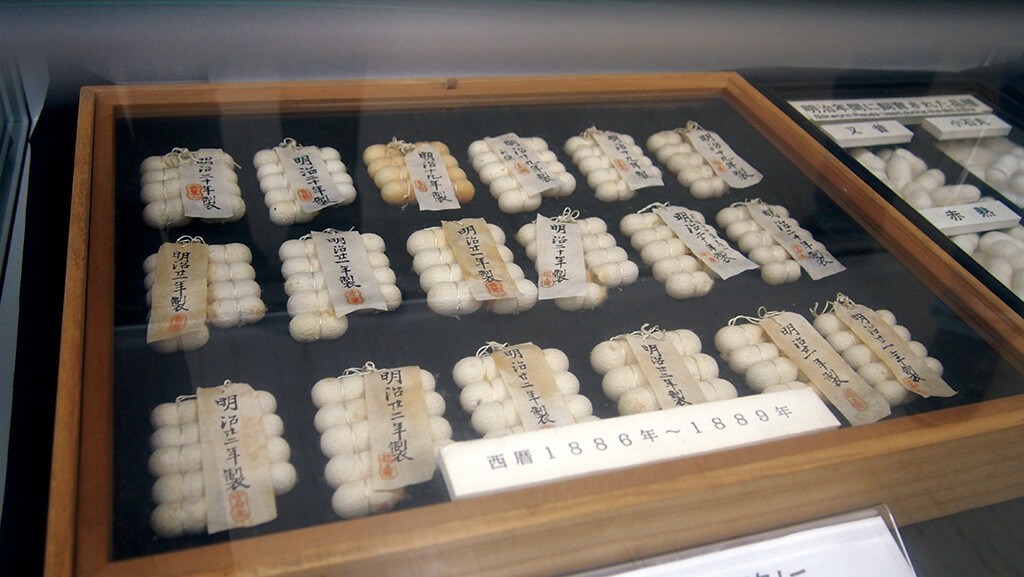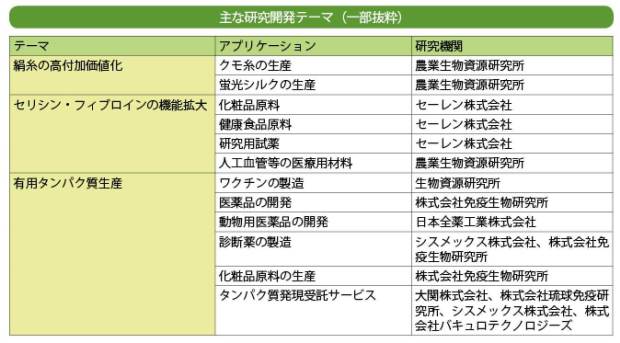- Information for Middle and High School Researchers
Tap the silkworm cocoon and you'll hear the sound of civilization.
2016.02.23
From the Meiji period to the early Showa period, the Japanese sericulture industry was the core of Japan's efforts to acquire foreign capital through the export of silk yarn, and laid the foundation of modern Japan as a driving force for civilization and enlightenment through a direct link to the global market. In the latter half of the 20th century, however, the production of cocoons continued to decline, and the country's position as the world's leading producer of cocoons was given to China. Japan has changed from being an "exporter" of raw silk to an "importer" of silk. In such a severe situation surrounding the sericultural industry, a movement to find a new way of sericultural activity other than the conventional "silk yarn production" has begun in the 21st century.
In 2000, the National Institute of Agrobiological Resources (NIBER) and others developed a genetically modified silkworm, which was followed by research and development in various fields such as drug development, production of useful proteins, food, and search for functional materials. In 2014, Japan's first test breeding of genetically modified silkworms in isolated breeding plots was approved (Approved by: National Institute of Agrobiological Resources). Japan's sericultural industry is now on the verge of a revolution.
This special issue explores the trends that will bring about the opening of civilization through the fusion of know-how cultivated in the long history of sericulture in Japan and cutting-edge science and technology.
."whySilkworms now? Adding Valueindicates such things as location of person or thing, location of short-term action, etc. challengebe just about to"
Until now, the sericulture industry in Japan has mainly been the sericulture and silk industry, which produces silk yarn. In order to obtain large quantities of high quality silk, silkworm breeding and rearing techniques have been accumulated to increase the size of cocoons, reduce the cost of rearing, and improve the productivity of silk yarn, etc. In more than 100 years of silkworm research, modern developments in chemistry and technology have transformed the silkworm from a producer of silk yarn to a biological resource with diverse values. The silkworm, once a silk producer, has been transformed into a biological resource with a variety of values.
R&D Trends
The main R&D themes that are attracting attention can be broadly classified into the following areas: value-adding of silk threads, expansion of applications of sericin and fibroin, components of silk threads, production of useful proteins, and utilization of pupae, which are industrial wastes. The fields of application are not limited to clothing, but include bio/healthcare, medicine/pharmaceuticals, food/feedstuff, materials/materials, devices, and many others. In Japan, there are several dozen companies that have developed businesses based on the results of their research, and some ventures have been newly established as a result of the silkworm business. In terms of building an industry, there are still few examples. On the other hand, research and development in academia is being conducted at universities and research institutes nationwide, and the National Institute of Agrobiological Resources (NIBER) is playing a central role in this field. As mentioned above, the National Institute of Agrobiological Resources is a leading example of genetically modified silkworm breeding, and has long been a center for silkworm research, taking on a variety of challenges.

Major R&D themes related to silkworms (excerpts)
Expanding applications of proteins that make up silk
The adhesive molecule sericin, which is a waste product when scouring silk threads from cocoons, is originally a highly purified protein. Sericin has been reported to inhibit the production of tyrosine, which causes blemishes, promote skin turnover, and inhibit wrinkles caused by ultraviolet rays, and the functional properties of sericin itself are increasingly being applied to cosmetics. Interestingly, in the field of cell culture, sericin has been found to promote cell proliferation to the extent that it can substitute for bovine serum added to the culture medium, and is sold as a cell culture reagent by a biotech manufacturer. Fibroin, a fiber protein that accounts for 70% of silk threads, is also considered a promising medical material, and is processed into various forms such as films, sponges, non-woven fabrics, and tubes, depending on the application, including artificial blood vessels, scaffold materials for regenerative medicine, and corneal transplants. Fibroin is also attracting attention in the U.S., although few products have been put to practical use and the medical field remains a major obstacle to its application.
Silkworm technology development has come this far.
The availability of genetic modification has major implications for the sericulture industry. It has already added several values to the silkworm. One of these is silk threads, including "glowing threads" that express GFP and have the performance of strong "spider silk. If further research and development can add conductivity, magnetism, and other functionalities, it could revolutionize the textile industry, turning clothing into wearable devices. Also worth mentioning is the silkworm as a biological factory. Technology has been developed to secrete the target protein in sericin using genetic recombination technology and to recover the target protein with high purity, as well as to use a virus to make the silkworm larvae and pupae produce the protein inside their bodies. Since the production cost is lower than the method using cultured animal cells and the protein folding is more accurate, it is expected to be applied to diagnostic antibodies, cosmetic materials, and pharmaceuticals (vaccines and antibodies). In addition, advances in genetic modification technology have led to the development of silkworms that serve as models for human pathology, and cases have emerged in which silkworms are used for screening of drug candidate substances.
Silkworms have contributed to the development of genetics as well as to the promotion of industry in the development of civilization. Mendel's laws were confirmed early among animals, and the entire genome was almost completely deciphered in 2004. Genetic research has been actively promoted due to the need for breed improvement, and has finally reached the point where genetically modified silkworms are being used for industrial purposes. The combination of accumulated molecular biological know-how and Japan's expertise in breeding and rearing silkworms is now bringing the sericultural industry back into full bloom. It is hoped that silkworms, which have sprung out of the textile industry, will overturn existing concepts and become the foundation for building a new industry. (Text by Yu Togane)
From the booklet "AGRI GARAGE
